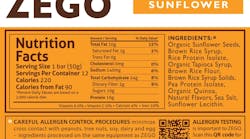Definitions of intelligent (or smart) and active packaging abound. For the purposes of this article, “smart packaging” interacts with consumers — via smartphone, for instance. “Active packaging,” on the other hand, interacts with its own internal or external environment. In-pack odor-absorbing patches are in this camp.
Smart and active packages are finding a home in many product categories for applications ranging from the seriously fun to the decidedly serious. A fun and functional example comes from the Häagen-Dazs brand, which offers the Häagen-Dazs Concerto Timer app and companion packaging for all of its 14-oz. cartons of ice cream.
After downloading the free app, the consumer points an iPhone at the top of the Häagen-Dazs carton and — through the magic of augmented-reality technology — a tiny, ethereal violinist appears and plays Bach Inventions No. 14. The little concert is on your smartphone, but if you hold the phone just right, it appears to be on top of your ice cream carton. The interlude lasts for two minutes, which is just the right amount of time to let the ice cream soften before serving.
“The whole idea [for] the app came from our consumers," says Joy Richardson, marketing associate for Häagen-Dazs at Nestlé USA, Glendale, Calif. "A lot of Häagen-Dazs fans know that when they take out Häagen-Dazs from their freezer, it’s really cold and dense. That’s due to the high quality of the ice cream.” Within the U.S., the Häagen-Dazs trademark is licensed to Nestlé by brand owner General Mills.
“When you allow the ice cream to sit, or what we call ‘temper,’ for a rest of two minutes, it allows the flavors and texture to bloom,” she adds. “You get a much better eating experience once you let that ice cream temper a bit.”
If the consumer is tempering more than one carton of the ice cream at a time, an expanded version of the augmented-reality experience can be created. Pointing an app-enabled iPhone at the first carton makes the violinist appear, and pointing it at a second carton makes a cellist emerge.
“The two performances are separate; however, they meld together beautifully,” Richardson says. “We chose augmented-reality technology due to its uniqueness and the high level of engagement,” she adds. The technology provides consumers with “a cutting-edge, 3D type of experience.”
To sweeten the deal, so to speak, the brand also is donating $5 for every app download to honey bee research at the University of California at Davis (up to a $75,000 donation, in total).
The brand’s ad agency of record, Goodby, Silverstein & Partners San Francisco, worked digital production company Jam3, Toronto, to create the Häagen-Dazs Concerto Timer app.
Allergen info via QR code
Although Zego’s product formulation is free of the eight major food allergens — such as soy, nuts, dairy and gluten — the bars are made in a shared facility, so the possibility of cross contamination is possible.
Therefore, the company has the University of Nebraska’s Food Allergen Research and Resource Project test a sample from each batch of Zego bars to verify that they meet the FDA’s gluten-free guidelines and to measure peanut, soy, almond and dairy residue (if any) in the product.
The QR code is printed on the back of each wrapper, under the nutrition facts panel. Scanning the code with a smartphone gives consumers access to that batch’s allergen test results as well as a way to communicate directly with the company.
“We’re not saying that we can guarantee that our product is safe for anyone, but we can give you a lot more information than you’re used to having, which will help you make a better-informed decision,” Kavanagh continues. “This is the kind of information that consumers should have at their fingertips, whether it’s for themselves or their kids.”
Regarding processor allergen testing and consumer access to the test results, she adds, “We really would like it to catch on like wildfire and have consumers start to accept it and demand it of manufacturers. Imagine a landscape where a mother could be shopping, and she could scan [a package and] pull up the allergen test results right then and there.”
School teachers and other intermediaries also can use the on-pack QR code to make sure the product is appropriate for distribution to their constituencies.
Underlying each of these scenarios is fast, easy access to the allergen information. “You have to make it really convenient,” Kavanagh says. “I could say go to my website and look it up, [but] that’s not useful.”
Active packaging gets busy
Various approaches to active packaging, including antimicrobial and oxygen-scavenging films and packages that breathe, are not new. But new twists continue to emerge in support of nascent product concepts and packaging applications.
So-called snack eggs from The Original Egg Co., Staffordshire, U.K., illustrate the point. Each egg package contains an odor-absorbing patch to keep smells from building up inside the pouch, which contains a single shelled, hard-boiled egg. The Original Egg Co. is a business unit of U.K. egg producer and packer Stonegate, which specializes in free-range and organic eggs.
It was, in fact, the odor-absorbing patch that made individually packaged snack eggs commercially viable. Initially, the brand owner tried packaging the eggs in a pouch that did not have odor-absorbing properties.
He adds that in retail trials the initial package “was rejected for that reason — because of the odor. So they went back to the drawing board.” After a package redesign to conquer the problem, the product launched successfully in the United Kingdom at retailer Waitrose, Berkshire, U.K.
Like the old package, the new one is a flow-wrapped pouch. The odor-absorbing patch is integrated into the automated packaging operation, with a label applicator applying the patches to the film as it feeds into the flow wrapper. Thus each pouch that comes off the line is equipped with an internal patch.
Thanks at least in part to the patch, the on-the-go snack is “doing extremely well,” Balderson says. “You can open it up in the office, and you don’t have to worry about the smell.”
A variant of this odor-absorbing technology is used in meat packaging to eradicate odors that develop inside vacuum packs of beef, lamb, pork and poultry. In those instances, the technology is combined with a moisture-absorbing pad.
Sirane developed odor-absorbing pads for meat on behalf of Asda, West Yorkshire, U.K. The British retailer had been experiencing an unacceptably high level of returns of vacuum-packed meat, because of what the product smelled like when consumers opened the packages.“There’s a thing called confinement odor … which is a very strong smell that you get when you open a vacuum pack that’s had meat in it,” Balderson says, explaining that the odor develops when meat is held in an anaerobic environment. It’s a “stagnant, sour smell. It’s very unpleasant, and people were opening the packaging, thinking the meat was off and then taking it back to the store. [But] there was nothing wrong with the meat.”
To test the efficacy of the odor-absorbing pads in vacuum packs, Asda performed a one-million-package trial. The return rate was so low the retailer “then adopted [the technology] in every vacuum pack, and they tell all of their suppliers now to use it in all of the vacuum packaging,” Balderson says.
Fun factor
The pouch is printed with thermochromic (color-shifting) inks that make the “minion” character change from purple, when refrigerated, to yellow as the product warms up. To speed up the process, package text tells kids to press their finger on a circle printed just above the minion’s head.
The brand owner worked with flexible-packaging converter Printpack Inc., Atlanta, to create the package. The thermochromatic inks were supplied by Segan Industries Inc., Burlingame, Calif.
The package aimed to engage kids and their parents while delivering a fun experience. “Leveraging [thermochromic] ink for the ‘Despicable Me 2’ integration allowed us to bring a key piece of the storyline to life in a way that moms and kids found unique and engaging,” says Erica Jensen, integrated marketing manager for Yoplait, which is marketed in the U.S. by General Mills, Minneapolis.
The color-shifting pack generated buzz on social media, as well. “Moms and kids loved the packaging.” Jensen says. “We saw some great Instagram and Vine video postings of moms and kids interacting with the ‘Despicable Me’ tubes.


